Deere & Company Skid-Steer Loader: Supplier Evaluation & Selection
VerifiedAdded on 2023/04/20
|14
|3636
|101
Case Study
AI Summary
This case study outlines a supplier evaluation and selection procedure for Deere & Company, specifically for integrating suppliers into the early phases of the skid-steer loader development, considering environmental and social criteria. It details the steps involved in supplier evaluation, from identifying evaluation categories and assigning weights to defining a scoring system, direct evaluation, and continuous performance review. The study also addresses potential challenges in each step, offering solutions to mitigate risks and improve the overall effectiveness of the supplier management process. Furthermore, it highlights the benefits of implementing a robust supplier evaluation procedure, such as improved delivery, flexibility, quality, and reliability, ultimately contributing to Deere & Company's reputation and consumer confidence. The goal is to provide a structured approach for selecting suppliers who meet the company's high standards and contribute to its long-term success.
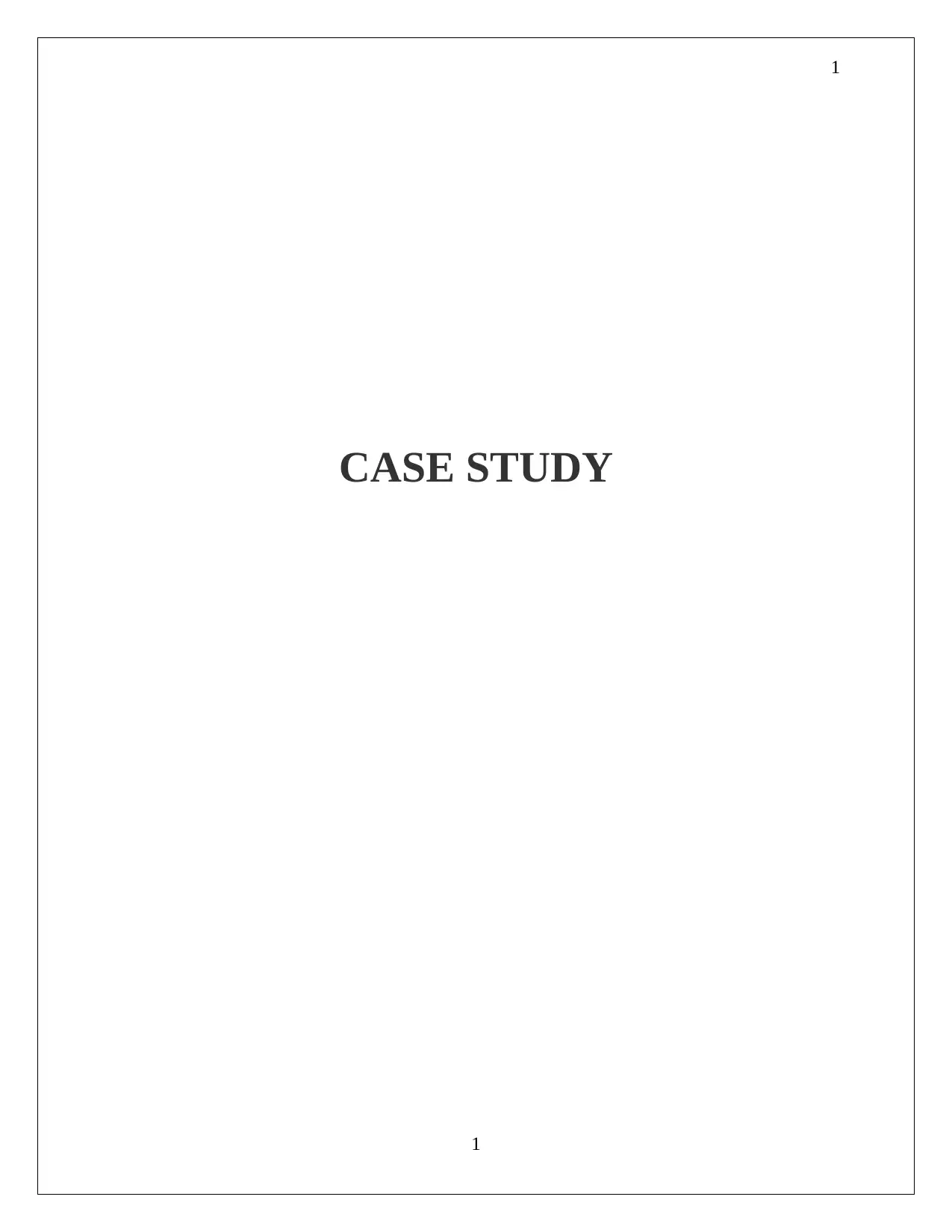
1
CASE STUDY
1
CASE STUDY
1
Paraphrase This Document
Need a fresh take? Get an instant paraphrase of this document with our AI Paraphraser
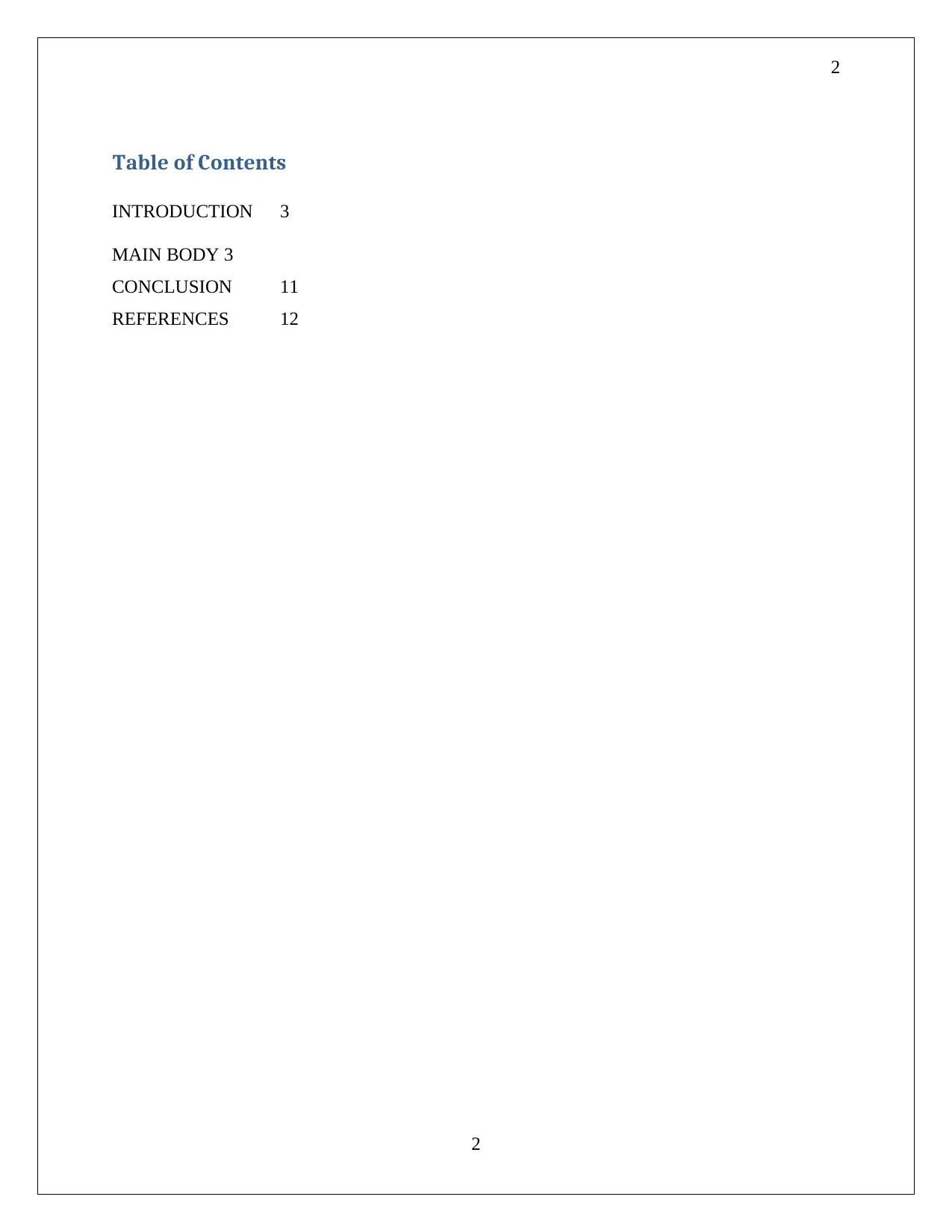
2
Table of Contents
INTRODUCTION 3
MAIN BODY 3
CONCLUSION 11
REFERENCES 12
2
Table of Contents
INTRODUCTION 3
MAIN BODY 3
CONCLUSION 11
REFERENCES 12
2
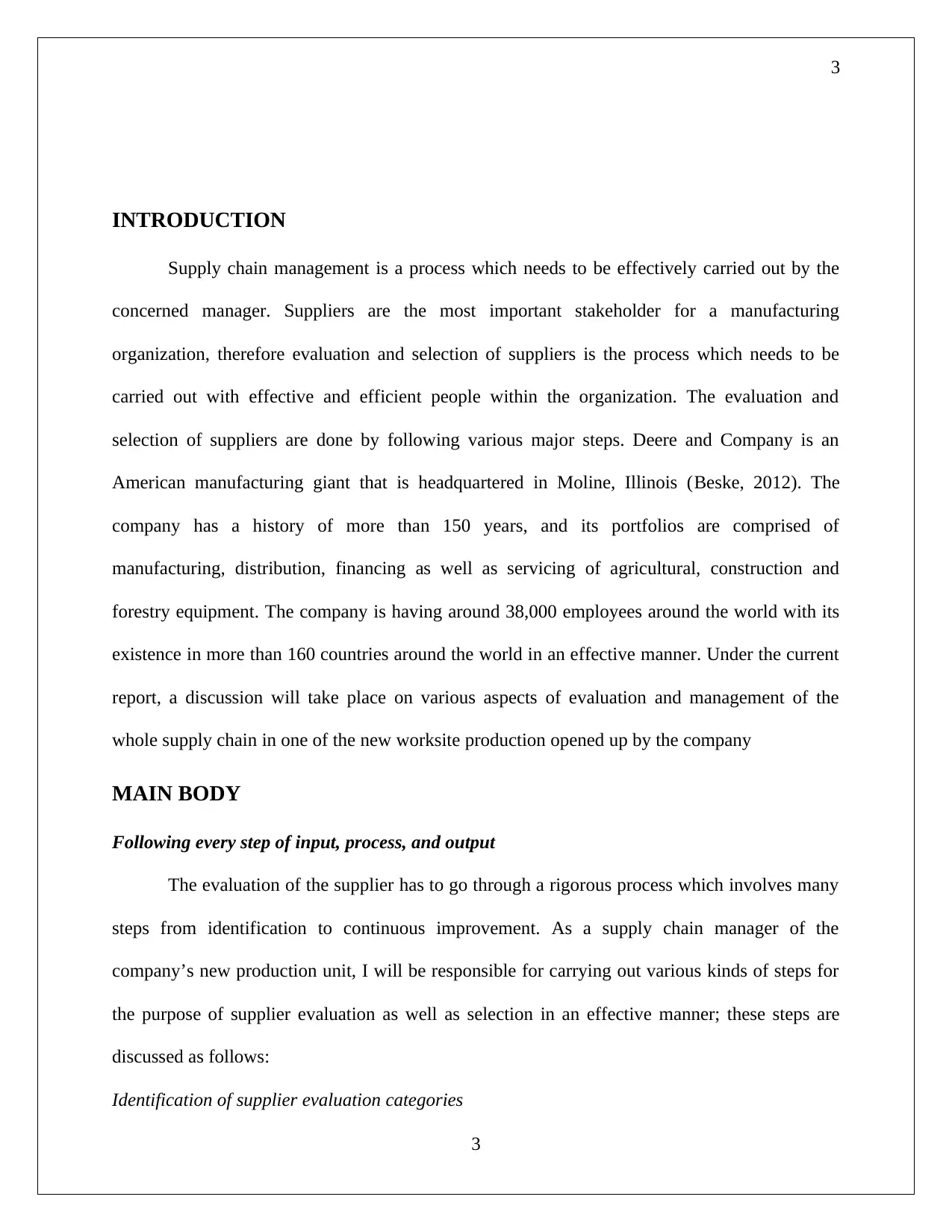
3
INTRODUCTION
Supply chain management is a process which needs to be effectively carried out by the
concerned manager. Suppliers are the most important stakeholder for a manufacturing
organization, therefore evaluation and selection of suppliers is the process which needs to be
carried out with effective and efficient people within the organization. The evaluation and
selection of suppliers are done by following various major steps. Deere and Company is an
American manufacturing giant that is headquartered in Moline, Illinois (Beske, 2012). The
company has a history of more than 150 years, and its portfolios are comprised of
manufacturing, distribution, financing as well as servicing of agricultural, construction and
forestry equipment. The company is having around 38,000 employees around the world with its
existence in more than 160 countries around the world in an effective manner. Under the current
report, a discussion will take place on various aspects of evaluation and management of the
whole supply chain in one of the new worksite production opened up by the company
MAIN BODY
Following every step of input, process, and output
The evaluation of the supplier has to go through a rigorous process which involves many
steps from identification to continuous improvement. As a supply chain manager of the
company’s new production unit, I will be responsible for carrying out various kinds of steps for
the purpose of supplier evaluation as well as selection in an effective manner; these steps are
discussed as follows:
Identification of supplier evaluation categories
3
INTRODUCTION
Supply chain management is a process which needs to be effectively carried out by the
concerned manager. Suppliers are the most important stakeholder for a manufacturing
organization, therefore evaluation and selection of suppliers is the process which needs to be
carried out with effective and efficient people within the organization. The evaluation and
selection of suppliers are done by following various major steps. Deere and Company is an
American manufacturing giant that is headquartered in Moline, Illinois (Beske, 2012). The
company has a history of more than 150 years, and its portfolios are comprised of
manufacturing, distribution, financing as well as servicing of agricultural, construction and
forestry equipment. The company is having around 38,000 employees around the world with its
existence in more than 160 countries around the world in an effective manner. Under the current
report, a discussion will take place on various aspects of evaluation and management of the
whole supply chain in one of the new worksite production opened up by the company
MAIN BODY
Following every step of input, process, and output
The evaluation of the supplier has to go through a rigorous process which involves many
steps from identification to continuous improvement. As a supply chain manager of the
company’s new production unit, I will be responsible for carrying out various kinds of steps for
the purpose of supplier evaluation as well as selection in an effective manner; these steps are
discussed as follows:
Identification of supplier evaluation categories
3
⊘ This is a preview!⊘
Do you want full access?
Subscribe today to unlock all pages.

Trusted by 1+ million students worldwide
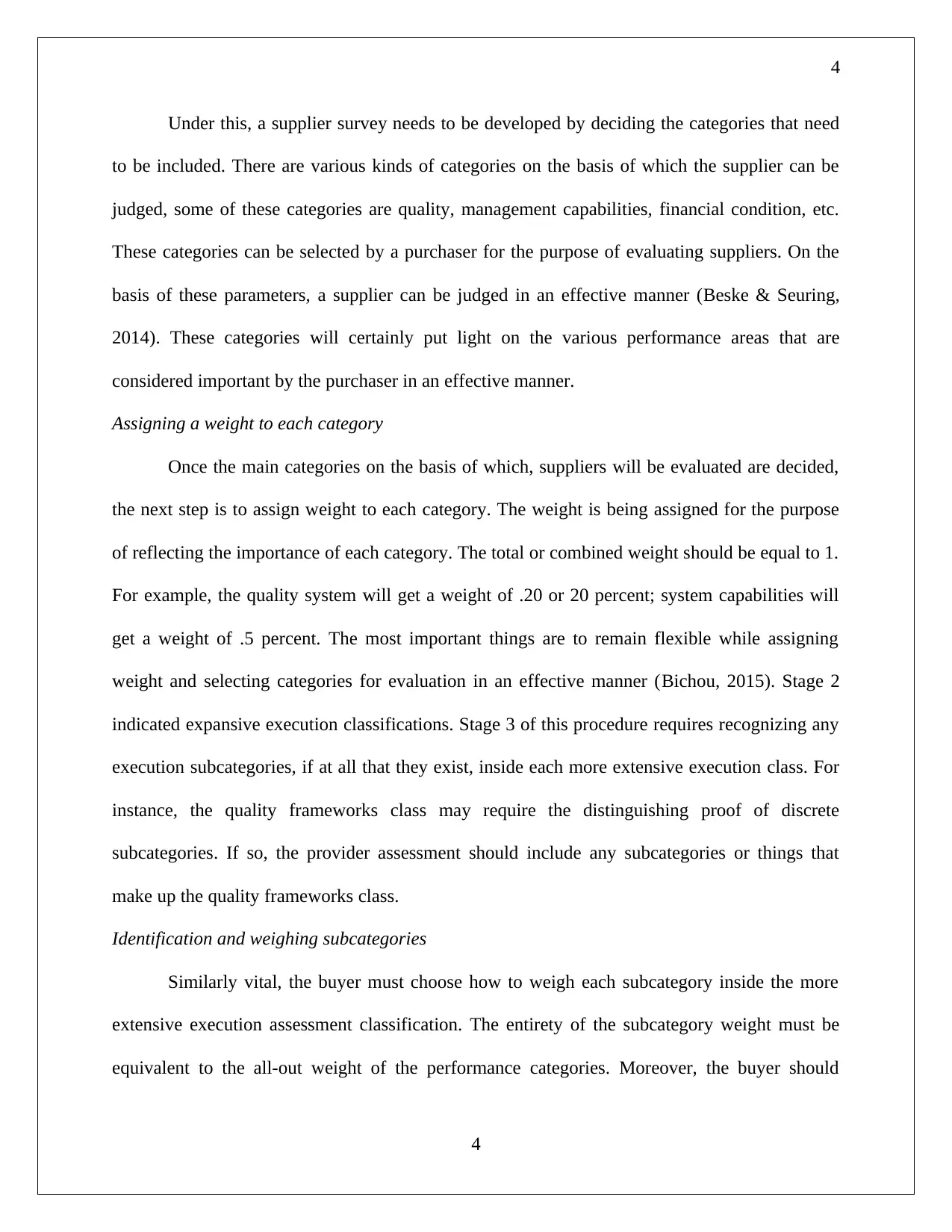
4
Under this, a supplier survey needs to be developed by deciding the categories that need
to be included. There are various kinds of categories on the basis of which the supplier can be
judged, some of these categories are quality, management capabilities, financial condition, etc.
These categories can be selected by a purchaser for the purpose of evaluating suppliers. On the
basis of these parameters, a supplier can be judged in an effective manner (Beske & Seuring,
2014). These categories will certainly put light on the various performance areas that are
considered important by the purchaser in an effective manner.
Assigning a weight to each category
Once the main categories on the basis of which, suppliers will be evaluated are decided,
the next step is to assign weight to each category. The weight is being assigned for the purpose
of reflecting the importance of each category. The total or combined weight should be equal to 1.
For example, the quality system will get a weight of .20 or 20 percent; system capabilities will
get a weight of .5 percent. The most important things are to remain flexible while assigning
weight and selecting categories for evaluation in an effective manner (Bichou, 2015). Stage 2
indicated expansive execution classifications. Stage 3 of this procedure requires recognizing any
execution subcategories, if at all that they exist, inside each more extensive execution class. For
instance, the quality frameworks class may require the distinguishing proof of discrete
subcategories. If so, the provider assessment should include any subcategories or things that
make up the quality frameworks class.
Identification and weighing subcategories
Similarly vital, the buyer must choose how to weigh each subcategory inside the more
extensive execution assessment classification. The entirety of the subcategory weight must be
equivalent to the all-out weight of the performance categories. Moreover, the buyer should
4
Under this, a supplier survey needs to be developed by deciding the categories that need
to be included. There are various kinds of categories on the basis of which the supplier can be
judged, some of these categories are quality, management capabilities, financial condition, etc.
These categories can be selected by a purchaser for the purpose of evaluating suppliers. On the
basis of these parameters, a supplier can be judged in an effective manner (Beske & Seuring,
2014). These categories will certainly put light on the various performance areas that are
considered important by the purchaser in an effective manner.
Assigning a weight to each category
Once the main categories on the basis of which, suppliers will be evaluated are decided,
the next step is to assign weight to each category. The weight is being assigned for the purpose
of reflecting the importance of each category. The total or combined weight should be equal to 1.
For example, the quality system will get a weight of .20 or 20 percent; system capabilities will
get a weight of .5 percent. The most important things are to remain flexible while assigning
weight and selecting categories for evaluation in an effective manner (Bichou, 2015). Stage 2
indicated expansive execution classifications. Stage 3 of this procedure requires recognizing any
execution subcategories, if at all that they exist, inside each more extensive execution class. For
instance, the quality frameworks class may require the distinguishing proof of discrete
subcategories. If so, the provider assessment should include any subcategories or things that
make up the quality frameworks class.
Identification and weighing subcategories
Similarly vital, the buyer must choose how to weigh each subcategory inside the more
extensive execution assessment classification. The entirety of the subcategory weight must be
equivalent to the all-out weight of the performance categories. Moreover, the buyer should
4
Paraphrase This Document
Need a fresh take? Get an instant paraphrase of this document with our AI Paraphraser
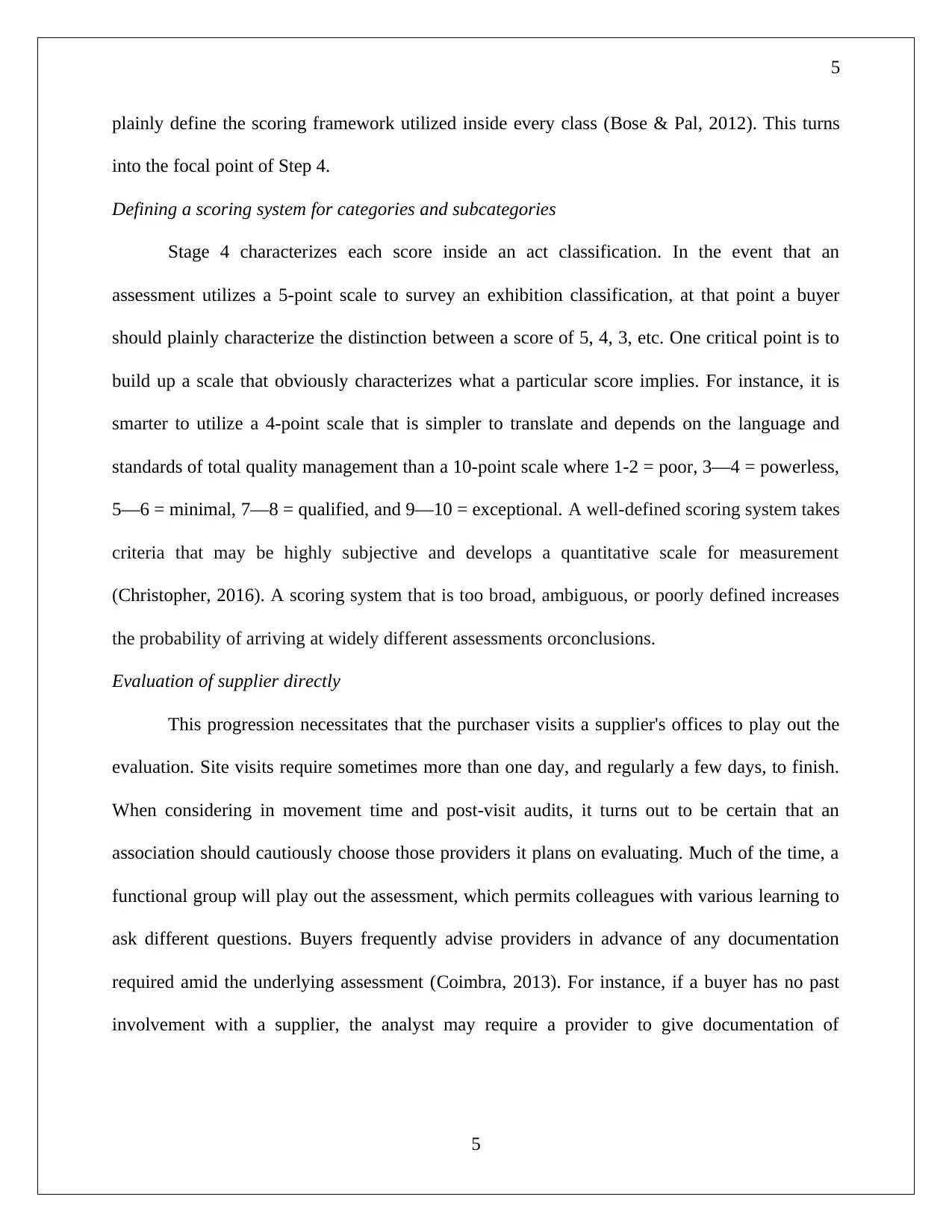
5
plainly define the scoring framework utilized inside every class (Bose & Pal, 2012). This turns
into the focal point of Step 4.
Defining a scoring system for categories and subcategories
Stage 4 characterizes each score inside an act classification. In the event that an
assessment utilizes a 5-point scale to survey an exhibition classification, at that point a buyer
should plainly characterize the distinction between a score of 5, 4, 3, etc. One critical point is to
build up a scale that obviously characterizes what a particular score implies. For instance, it is
smarter to utilize a 4-point scale that is simpler to translate and depends on the language and
standards of total quality management than a 10-point scale where 1-2 = poor, 3—4 = powerless,
5—6 = minimal, 7—8 = qualified, and 9—10 = exceptional. A well-defined scoring system takes
criteria that may be highly subjective and develops a quantitative scale for measurement
(Christopher, 2016). A scoring system that is too broad, ambiguous, or poorly defined increases
the probability of arriving at widely different assessments orconclusions.
Evaluation of supplier directly
This progression necessitates that the purchaser visits a supplier's offices to play out the
evaluation. Site visits require sometimes more than one day, and regularly a few days, to finish.
When considering in movement time and post-visit audits, it turns out to be certain that an
association should cautiously choose those providers it plans on evaluating. Much of the time, a
functional group will play out the assessment, which permits colleagues with various learning to
ask different questions. Buyers frequently advise providers in advance of any documentation
required amid the underlying assessment (Coimbra, 2013). For instance, if a buyer has no past
involvement with a supplier, the analyst may require a provider to give documentation of
5
plainly define the scoring framework utilized inside every class (Bose & Pal, 2012). This turns
into the focal point of Step 4.
Defining a scoring system for categories and subcategories
Stage 4 characterizes each score inside an act classification. In the event that an
assessment utilizes a 5-point scale to survey an exhibition classification, at that point a buyer
should plainly characterize the distinction between a score of 5, 4, 3, etc. One critical point is to
build up a scale that obviously characterizes what a particular score implies. For instance, it is
smarter to utilize a 4-point scale that is simpler to translate and depends on the language and
standards of total quality management than a 10-point scale where 1-2 = poor, 3—4 = powerless,
5—6 = minimal, 7—8 = qualified, and 9—10 = exceptional. A well-defined scoring system takes
criteria that may be highly subjective and develops a quantitative scale for measurement
(Christopher, 2016). A scoring system that is too broad, ambiguous, or poorly defined increases
the probability of arriving at widely different assessments orconclusions.
Evaluation of supplier directly
This progression necessitates that the purchaser visits a supplier's offices to play out the
evaluation. Site visits require sometimes more than one day, and regularly a few days, to finish.
When considering in movement time and post-visit audits, it turns out to be certain that an
association should cautiously choose those providers it plans on evaluating. Much of the time, a
functional group will play out the assessment, which permits colleagues with various learning to
ask different questions. Buyers frequently advise providers in advance of any documentation
required amid the underlying assessment (Coimbra, 2013). For instance, if a buyer has no past
involvement with a supplier, the analyst may require a provider to give documentation of
5
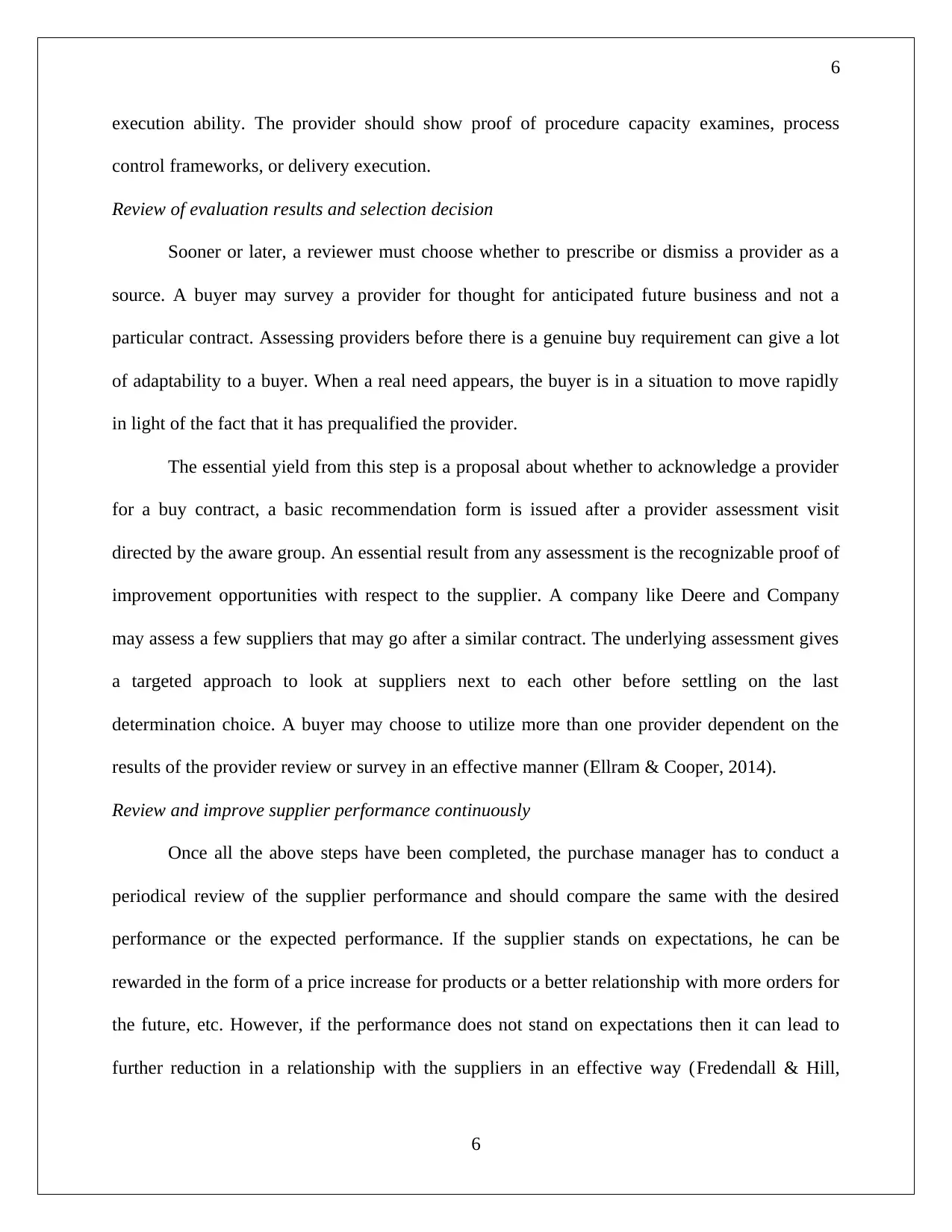
6
execution ability. The provider should show proof of procedure capacity examines, process
control frameworks, or delivery execution.
Review of evaluation results and selection decision
Sooner or later, a reviewer must choose whether to prescribe or dismiss a provider as a
source. A buyer may survey a provider for thought for anticipated future business and not a
particular contract. Assessing providers before there is a genuine buy requirement can give a lot
of adaptability to a buyer. When a real need appears, the buyer is in a situation to move rapidly
in light of the fact that it has prequalified the provider.
The essential yield from this step is a proposal about whether to acknowledge a provider
for a buy contract, a basic recommendation form is issued after a provider assessment visit
directed by the aware group. An essential result from any assessment is the recognizable proof of
improvement opportunities with respect to the supplier. A company like Deere and Company
may assess a few suppliers that may go after a similar contract. The underlying assessment gives
a targeted approach to look at suppliers next to each other before settling on the last
determination choice. A buyer may choose to utilize more than one provider dependent on the
results of the provider review or survey in an effective manner (Ellram & Cooper, 2014).
Review and improve supplier performance continuously
Once all the above steps have been completed, the purchase manager has to conduct a
periodical review of the supplier performance and should compare the same with the desired
performance or the expected performance. If the supplier stands on expectations, he can be
rewarded in the form of a price increase for products or a better relationship with more orders for
the future, etc. However, if the performance does not stand on expectations then it can lead to
further reduction in a relationship with the suppliers in an effective way (Fredendall & Hill,
6
execution ability. The provider should show proof of procedure capacity examines, process
control frameworks, or delivery execution.
Review of evaluation results and selection decision
Sooner or later, a reviewer must choose whether to prescribe or dismiss a provider as a
source. A buyer may survey a provider for thought for anticipated future business and not a
particular contract. Assessing providers before there is a genuine buy requirement can give a lot
of adaptability to a buyer. When a real need appears, the buyer is in a situation to move rapidly
in light of the fact that it has prequalified the provider.
The essential yield from this step is a proposal about whether to acknowledge a provider
for a buy contract, a basic recommendation form is issued after a provider assessment visit
directed by the aware group. An essential result from any assessment is the recognizable proof of
improvement opportunities with respect to the supplier. A company like Deere and Company
may assess a few suppliers that may go after a similar contract. The underlying assessment gives
a targeted approach to look at suppliers next to each other before settling on the last
determination choice. A buyer may choose to utilize more than one provider dependent on the
results of the provider review or survey in an effective manner (Ellram & Cooper, 2014).
Review and improve supplier performance continuously
Once all the above steps have been completed, the purchase manager has to conduct a
periodical review of the supplier performance and should compare the same with the desired
performance or the expected performance. If the supplier stands on expectations, he can be
rewarded in the form of a price increase for products or a better relationship with more orders for
the future, etc. However, if the performance does not stand on expectations then it can lead to
further reduction in a relationship with the suppliers in an effective way (Fredendall & Hill,
6
⊘ This is a preview!⊘
Do you want full access?
Subscribe today to unlock all pages.

Trusted by 1+ million students worldwide

7
2016). Deere and Company is an organization with high standards and reputation among
consumers and therefore any performance lack from the side of the supplier should not be
accepted as it will directly impact the quality of product and thus, the confidence of consumer in
the longer run.
Possible challenges in each of the above steps and its solution
There are various possible challenges that Deere and Company might face while
implementing the supplier chain management process in an effective manner, these are discussed
as follows:
Identification of supplier evaluation categories
The main challenge that might be faced by the manager at this particular stage is the
existence of various categories and selecting particular categories for the purpose of evaluating
suppliers. The selection of those categories is a difficult task which has to be carried out very
carefully because the wrong selection of supplier evaluation category will direct lead to the
wrong selection of supplier and hence will make the whole process redundant and useless in the
longer run (Ghosh & Shah, 2015).
Assigning a weight to each category
Assigning a weight to each of the supplier evaluation categories is a vague concept in
itself, this is primarily because the weight is not given on a particular basis, and it has to be given
completely based on the judgment and assessment of the Deere and Company's management
(Saenz & Koufteros, 2015). Each company and its management might assign a different weight
to each category and thus the selection procedure of supplier will also change. Therefore, there is
no uniform code through which weight is assigned to each category in an effective way.
Identification and weighing subcategories
7
2016). Deere and Company is an organization with high standards and reputation among
consumers and therefore any performance lack from the side of the supplier should not be
accepted as it will directly impact the quality of product and thus, the confidence of consumer in
the longer run.
Possible challenges in each of the above steps and its solution
There are various possible challenges that Deere and Company might face while
implementing the supplier chain management process in an effective manner, these are discussed
as follows:
Identification of supplier evaluation categories
The main challenge that might be faced by the manager at this particular stage is the
existence of various categories and selecting particular categories for the purpose of evaluating
suppliers. The selection of those categories is a difficult task which has to be carried out very
carefully because the wrong selection of supplier evaluation category will direct lead to the
wrong selection of supplier and hence will make the whole process redundant and useless in the
longer run (Ghosh & Shah, 2015).
Assigning a weight to each category
Assigning a weight to each of the supplier evaluation categories is a vague concept in
itself, this is primarily because the weight is not given on a particular basis, and it has to be given
completely based on the judgment and assessment of the Deere and Company's management
(Saenz & Koufteros, 2015). Each company and its management might assign a different weight
to each category and thus the selection procedure of supplier will also change. Therefore, there is
no uniform code through which weight is assigned to each category in an effective way.
Identification and weighing subcategories
7
Paraphrase This Document
Need a fresh take? Get an instant paraphrase of this document with our AI Paraphraser
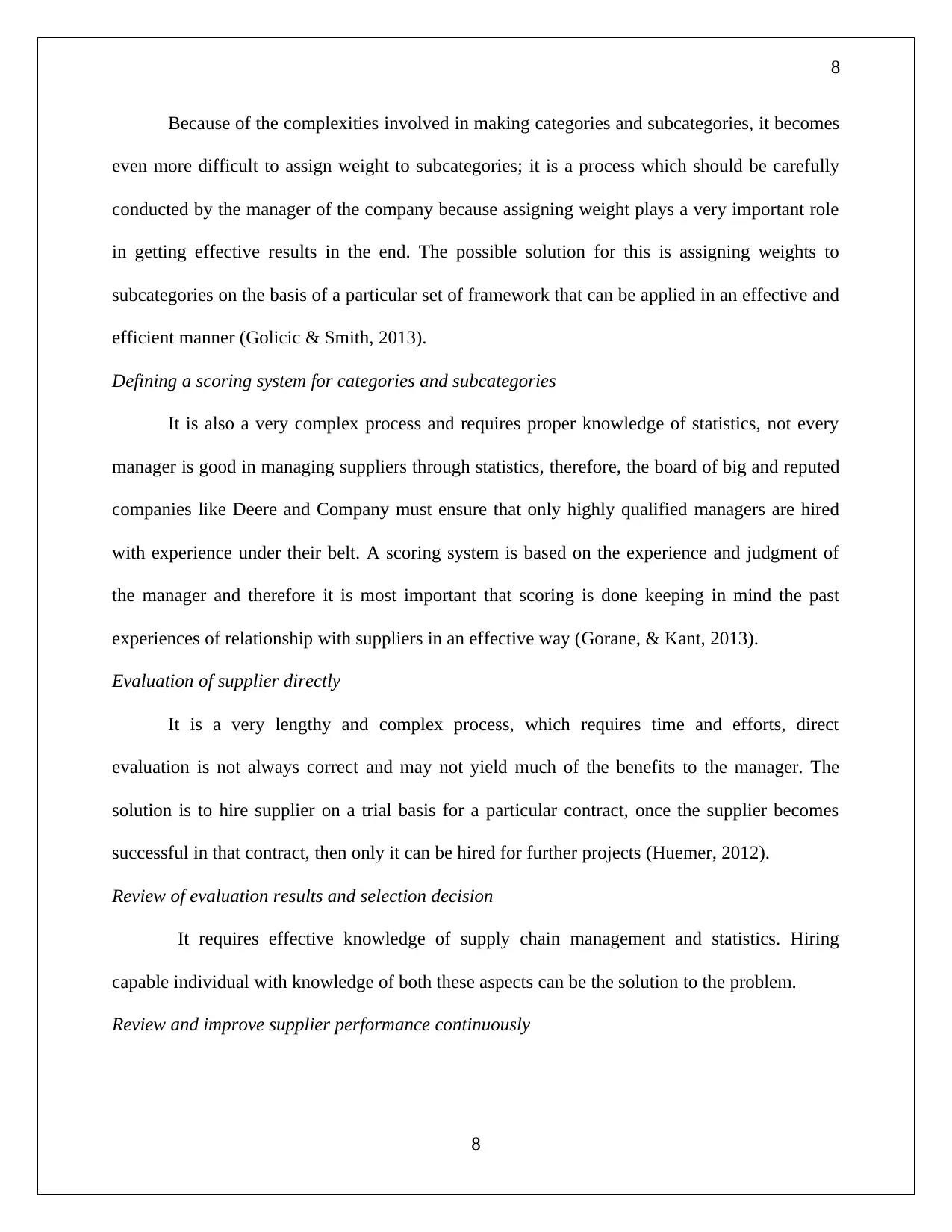
8
Because of the complexities involved in making categories and subcategories, it becomes
even more difficult to assign weight to subcategories; it is a process which should be carefully
conducted by the manager of the company because assigning weight plays a very important role
in getting effective results in the end. The possible solution for this is assigning weights to
subcategories on the basis of a particular set of framework that can be applied in an effective and
efficient manner (Golicic & Smith, 2013).
Defining a scoring system for categories and subcategories
It is also a very complex process and requires proper knowledge of statistics, not every
manager is good in managing suppliers through statistics, therefore, the board of big and reputed
companies like Deere and Company must ensure that only highly qualified managers are hired
with experience under their belt. A scoring system is based on the experience and judgment of
the manager and therefore it is most important that scoring is done keeping in mind the past
experiences of relationship with suppliers in an effective way (Gorane, & Kant, 2013).
Evaluation of supplier directly
It is a very lengthy and complex process, which requires time and efforts, direct
evaluation is not always correct and may not yield much of the benefits to the manager. The
solution is to hire supplier on a trial basis for a particular contract, once the supplier becomes
successful in that contract, then only it can be hired for further projects (Huemer, 2012).
Review of evaluation results and selection decision
It requires effective knowledge of supply chain management and statistics. Hiring
capable individual with knowledge of both these aspects can be the solution to the problem.
Review and improve supplier performance continuously
8
Because of the complexities involved in making categories and subcategories, it becomes
even more difficult to assign weight to subcategories; it is a process which should be carefully
conducted by the manager of the company because assigning weight plays a very important role
in getting effective results in the end. The possible solution for this is assigning weights to
subcategories on the basis of a particular set of framework that can be applied in an effective and
efficient manner (Golicic & Smith, 2013).
Defining a scoring system for categories and subcategories
It is also a very complex process and requires proper knowledge of statistics, not every
manager is good in managing suppliers through statistics, therefore, the board of big and reputed
companies like Deere and Company must ensure that only highly qualified managers are hired
with experience under their belt. A scoring system is based on the experience and judgment of
the manager and therefore it is most important that scoring is done keeping in mind the past
experiences of relationship with suppliers in an effective way (Gorane, & Kant, 2013).
Evaluation of supplier directly
It is a very lengthy and complex process, which requires time and efforts, direct
evaluation is not always correct and may not yield much of the benefits to the manager. The
solution is to hire supplier on a trial basis for a particular contract, once the supplier becomes
successful in that contract, then only it can be hired for further projects (Huemer, 2012).
Review of evaluation results and selection decision
It requires effective knowledge of supply chain management and statistics. Hiring
capable individual with knowledge of both these aspects can be the solution to the problem.
Review and improve supplier performance continuously
8
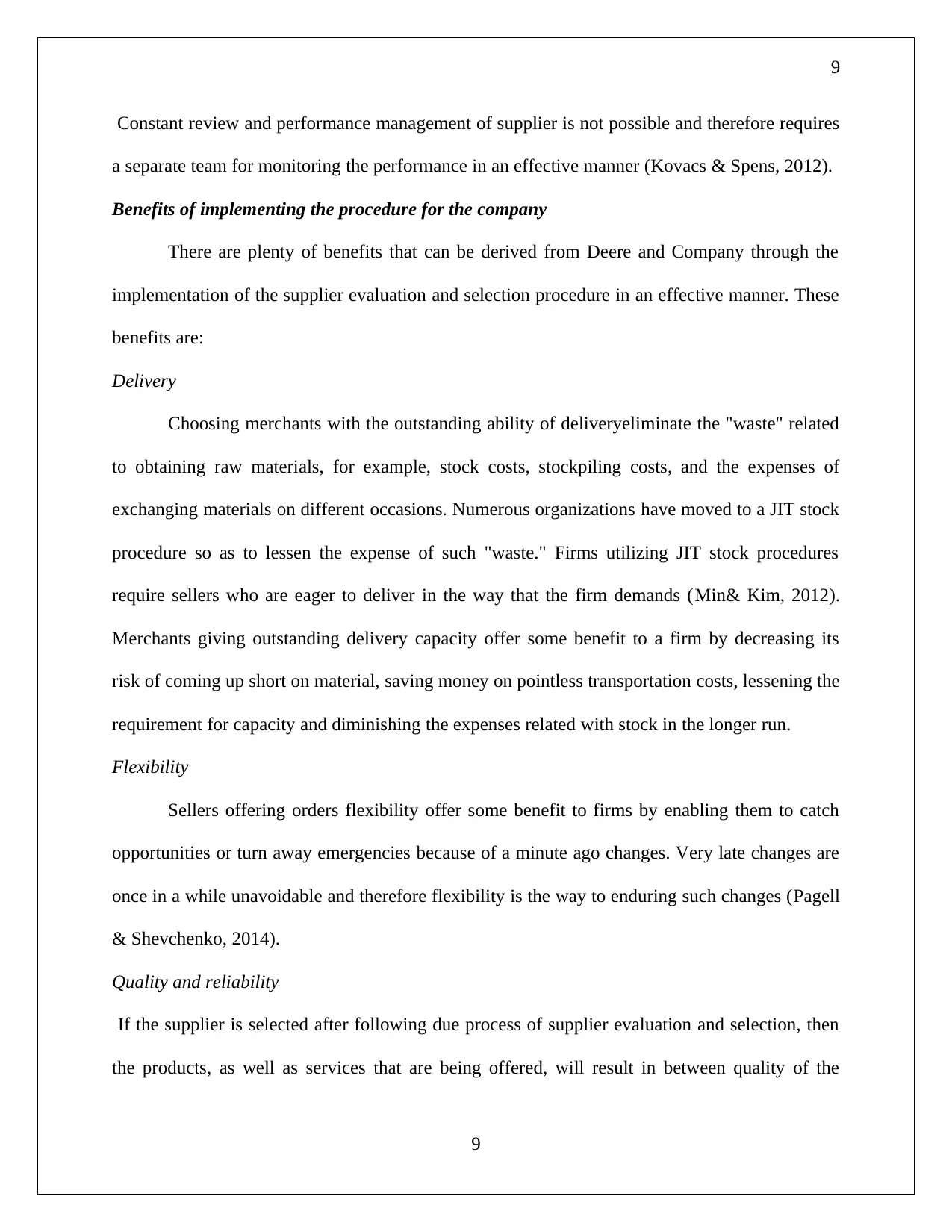
9
Constant review and performance management of supplier is not possible and therefore requires
a separate team for monitoring the performance in an effective manner (Kovacs & Spens, 2012).
Benefits of implementing the procedure for the company
There are plenty of benefits that can be derived from Deere and Company through the
implementation of the supplier evaluation and selection procedure in an effective manner. These
benefits are:
Delivery
Choosing merchants with the outstanding ability of deliveryeliminate the "waste" related
to obtaining raw materials, for example, stock costs, stockpiling costs, and the expenses of
exchanging materials on different occasions. Numerous organizations have moved to a JIT stock
procedure so as to lessen the expense of such "waste." Firms utilizing JIT stock procedures
require sellers who are eager to deliver in the way that the firm demands (Min& Kim, 2012).
Merchants giving outstanding delivery capacity offer some benefit to a firm by decreasing its
risk of coming up short on material, saving money on pointless transportation costs, lessening the
requirement for capacity and diminishing the expenses related with stock in the longer run.
Flexibility
Sellers offering orders flexibility offer some benefit to firms by enabling them to catch
opportunities or turn away emergencies because of a minute ago changes. Very late changes are
once in a while unavoidable and therefore flexibility is the way to enduring such changes (Pagell
& Shevchenko, 2014).
Quality and reliability
If the supplier is selected after following due process of supplier evaluation and selection, then
the products, as well as services that are being offered, will result in between quality of the
9
Constant review and performance management of supplier is not possible and therefore requires
a separate team for monitoring the performance in an effective manner (Kovacs & Spens, 2012).
Benefits of implementing the procedure for the company
There are plenty of benefits that can be derived from Deere and Company through the
implementation of the supplier evaluation and selection procedure in an effective manner. These
benefits are:
Delivery
Choosing merchants with the outstanding ability of deliveryeliminate the "waste" related
to obtaining raw materials, for example, stock costs, stockpiling costs, and the expenses of
exchanging materials on different occasions. Numerous organizations have moved to a JIT stock
procedure so as to lessen the expense of such "waste." Firms utilizing JIT stock procedures
require sellers who are eager to deliver in the way that the firm demands (Min& Kim, 2012).
Merchants giving outstanding delivery capacity offer some benefit to a firm by decreasing its
risk of coming up short on material, saving money on pointless transportation costs, lessening the
requirement for capacity and diminishing the expenses related with stock in the longer run.
Flexibility
Sellers offering orders flexibility offer some benefit to firms by enabling them to catch
opportunities or turn away emergencies because of a minute ago changes. Very late changes are
once in a while unavoidable and therefore flexibility is the way to enduring such changes (Pagell
& Shevchenko, 2014).
Quality and reliability
If the supplier is selected after following due process of supplier evaluation and selection, then
the products, as well as services that are being offered, will result in between quality of the
9
⊘ This is a preview!⊘
Do you want full access?
Subscribe today to unlock all pages.

Trusted by 1+ million students worldwide
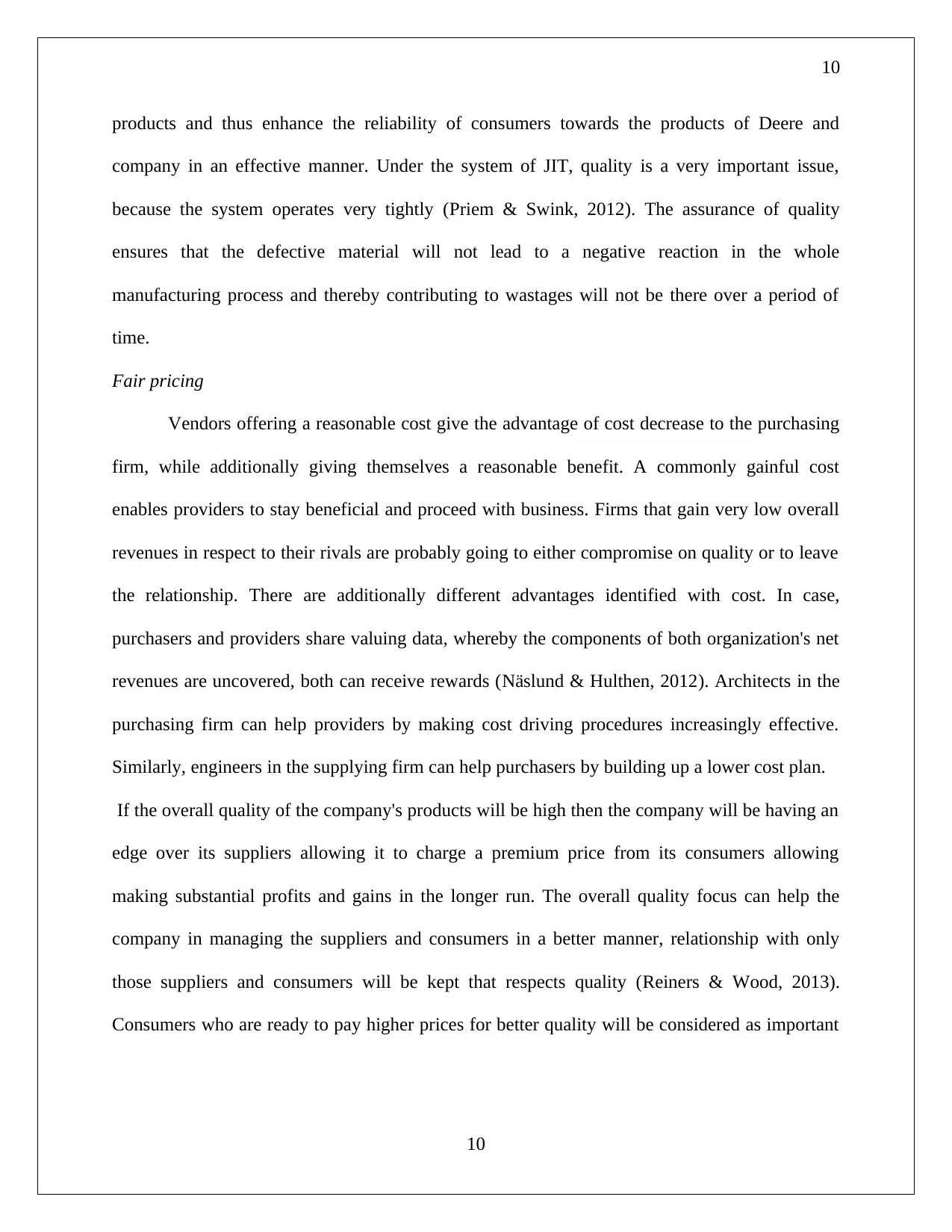
10
products and thus enhance the reliability of consumers towards the products of Deere and
company in an effective manner. Under the system of JIT, quality is a very important issue,
because the system operates very tightly (Priem & Swink, 2012). The assurance of quality
ensures that the defective material will not lead to a negative reaction in the whole
manufacturing process and thereby contributing to wastages will not be there over a period of
time.
Fair pricing
Vendors offering a reasonable cost give the advantage of cost decrease to the purchasing
firm, while additionally giving themselves a reasonable benefit. A commonly gainful cost
enables providers to stay beneficial and proceed with business. Firms that gain very low overall
revenues in respect to their rivals are probably going to either compromise on quality or to leave
the relationship. There are additionally different advantages identified with cost. In case,
purchasers and providers share valuing data, whereby the components of both organization's net
revenues are uncovered, both can receive rewards (Näslund & Hulthen, 2012). Architects in the
purchasing firm can help providers by making cost driving procedures increasingly effective.
Similarly, engineers in the supplying firm can help purchasers by building up a lower cost plan.
If the overall quality of the company's products will be high then the company will be having an
edge over its suppliers allowing it to charge a premium price from its consumers allowing
making substantial profits and gains in the longer run. The overall quality focus can help the
company in managing the suppliers and consumers in a better manner, relationship with only
those suppliers and consumers will be kept that respects quality (Reiners & Wood, 2013).
Consumers who are ready to pay higher prices for better quality will be considered as important
10
products and thus enhance the reliability of consumers towards the products of Deere and
company in an effective manner. Under the system of JIT, quality is a very important issue,
because the system operates very tightly (Priem & Swink, 2012). The assurance of quality
ensures that the defective material will not lead to a negative reaction in the whole
manufacturing process and thereby contributing to wastages will not be there over a period of
time.
Fair pricing
Vendors offering a reasonable cost give the advantage of cost decrease to the purchasing
firm, while additionally giving themselves a reasonable benefit. A commonly gainful cost
enables providers to stay beneficial and proceed with business. Firms that gain very low overall
revenues in respect to their rivals are probably going to either compromise on quality or to leave
the relationship. There are additionally different advantages identified with cost. In case,
purchasers and providers share valuing data, whereby the components of both organization's net
revenues are uncovered, both can receive rewards (Näslund & Hulthen, 2012). Architects in the
purchasing firm can help providers by making cost driving procedures increasingly effective.
Similarly, engineers in the supplying firm can help purchasers by building up a lower cost plan.
If the overall quality of the company's products will be high then the company will be having an
edge over its suppliers allowing it to charge a premium price from its consumers allowing
making substantial profits and gains in the longer run. The overall quality focus can help the
company in managing the suppliers and consumers in a better manner, relationship with only
those suppliers and consumers will be kept that respects quality (Reiners & Wood, 2013).
Consumers who are ready to pay higher prices for better quality will be considered as important
10
Paraphrase This Document
Need a fresh take? Get an instant paraphrase of this document with our AI Paraphraser
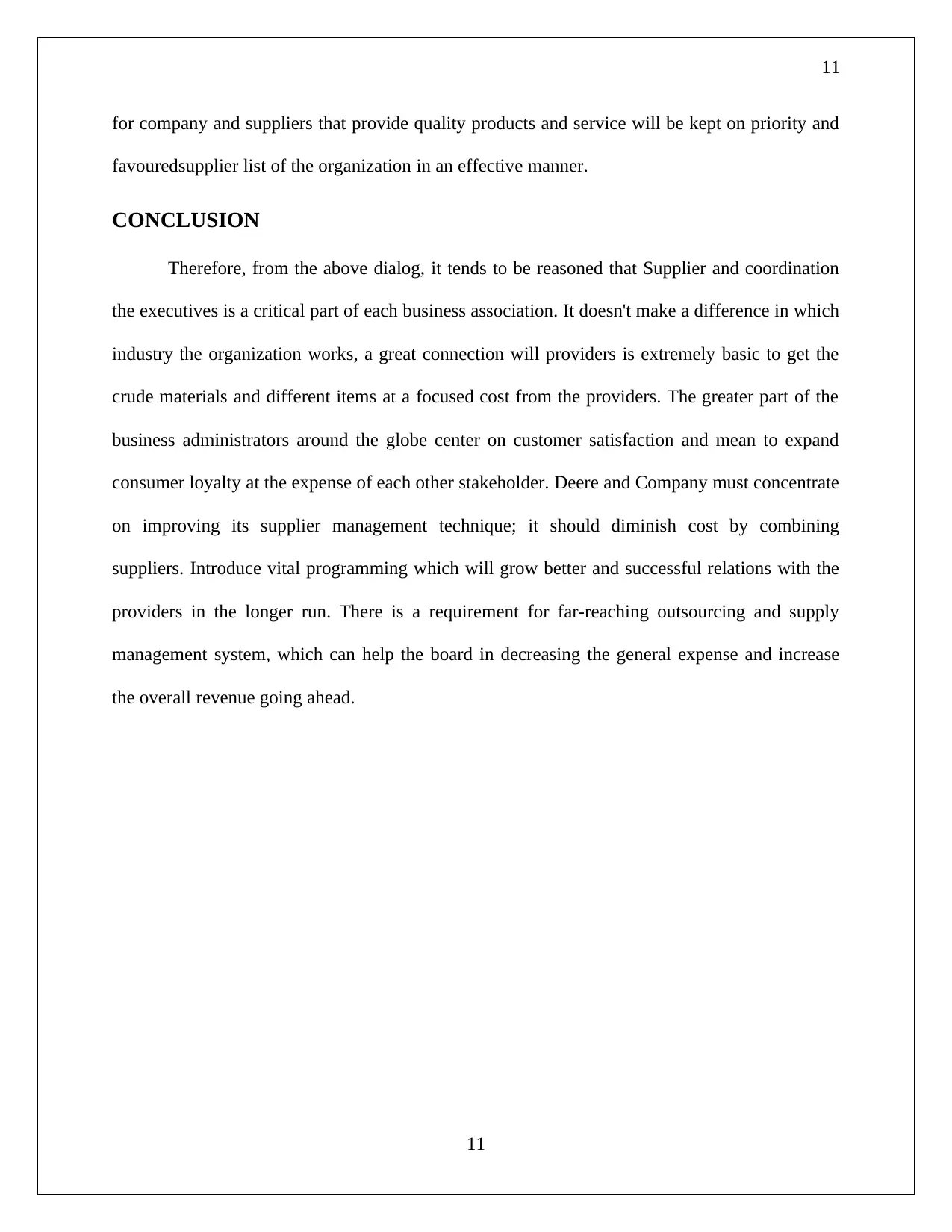
11
for company and suppliers that provide quality products and service will be kept on priority and
favouredsupplier list of the organization in an effective manner.
CONCLUSION
Therefore, from the above dialog, it tends to be reasoned that Supplier and coordination
the executives is a critical part of each business association. It doesn't make a difference in which
industry the organization works, a great connection will providers is extremely basic to get the
crude materials and different items at a focused cost from the providers. The greater part of the
business administrators around the globe center on customer satisfaction and mean to expand
consumer loyalty at the expense of each other stakeholder. Deere and Company must concentrate
on improving its supplier management technique; it should diminish cost by combining
suppliers. Introduce vital programming which will grow better and successful relations with the
providers in the longer run. There is a requirement for far-reaching outsourcing and supply
management system, which can help the board in decreasing the general expense and increase
the overall revenue going ahead.
11
for company and suppliers that provide quality products and service will be kept on priority and
favouredsupplier list of the organization in an effective manner.
CONCLUSION
Therefore, from the above dialog, it tends to be reasoned that Supplier and coordination
the executives is a critical part of each business association. It doesn't make a difference in which
industry the organization works, a great connection will providers is extremely basic to get the
crude materials and different items at a focused cost from the providers. The greater part of the
business administrators around the globe center on customer satisfaction and mean to expand
consumer loyalty at the expense of each other stakeholder. Deere and Company must concentrate
on improving its supplier management technique; it should diminish cost by combining
suppliers. Introduce vital programming which will grow better and successful relations with the
providers in the longer run. There is a requirement for far-reaching outsourcing and supply
management system, which can help the board in decreasing the general expense and increase
the overall revenue going ahead.
11
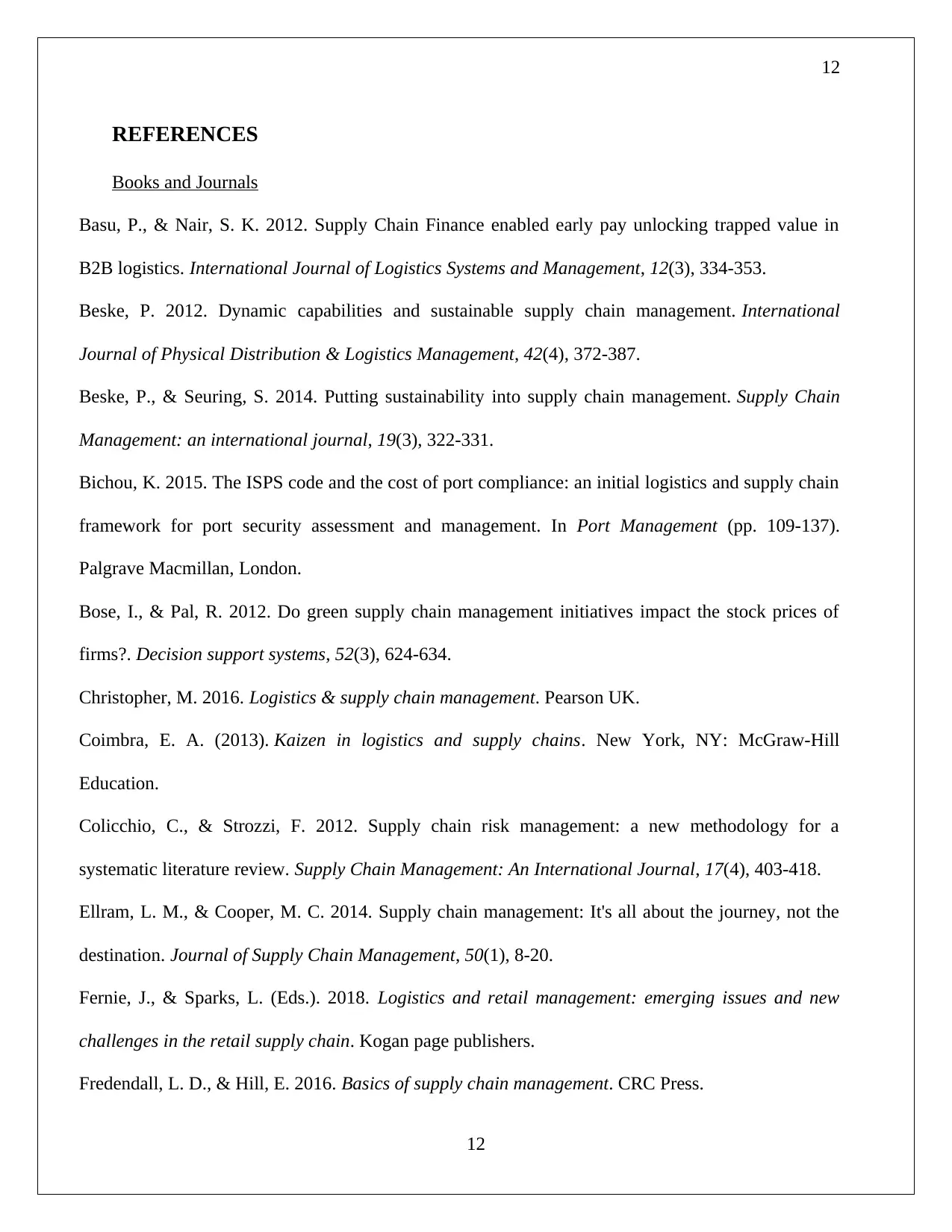
12
REFERENCES
Books and Journals
Basu, P., & Nair, S. K. 2012. Supply Chain Finance enabled early pay unlocking trapped value in
B2B logistics. International Journal of Logistics Systems and Management, 12(3), 334-353.
Beske, P. 2012. Dynamic capabilities and sustainable supply chain management. International
Journal of Physical Distribution & Logistics Management, 42(4), 372-387.
Beske, P., & Seuring, S. 2014. Putting sustainability into supply chain management. Supply Chain
Management: an international journal, 19(3), 322-331.
Bichou, K. 2015. The ISPS code and the cost of port compliance: an initial logistics and supply chain
framework for port security assessment and management. In Port Management (pp. 109-137).
Palgrave Macmillan, London.
Bose, I., & Pal, R. 2012. Do green supply chain management initiatives impact the stock prices of
firms?. Decision support systems, 52(3), 624-634.
Christopher, M. 2016. Logistics & supply chain management. Pearson UK.
Coimbra, E. A. (2013). Kaizen in logistics and supply chains. New York, NY: McGraw-Hill
Education.
Colicchio, C., & Strozzi, F. 2012. Supply chain risk management: a new methodology for a
systematic literature review. Supply Chain Management: An International Journal, 17(4), 403-418.
Ellram, L. M., & Cooper, M. C. 2014. Supply chain management: It's all about the journey, not the
destination. Journal of Supply Chain Management, 50(1), 8-20.
Fernie, J., & Sparks, L. (Eds.). 2018. Logistics and retail management: emerging issues and new
challenges in the retail supply chain. Kogan page publishers.
Fredendall, L. D., & Hill, E. 2016. Basics of supply chain management. CRC Press.
12
REFERENCES
Books and Journals
Basu, P., & Nair, S. K. 2012. Supply Chain Finance enabled early pay unlocking trapped value in
B2B logistics. International Journal of Logistics Systems and Management, 12(3), 334-353.
Beske, P. 2012. Dynamic capabilities and sustainable supply chain management. International
Journal of Physical Distribution & Logistics Management, 42(4), 372-387.
Beske, P., & Seuring, S. 2014. Putting sustainability into supply chain management. Supply Chain
Management: an international journal, 19(3), 322-331.
Bichou, K. 2015. The ISPS code and the cost of port compliance: an initial logistics and supply chain
framework for port security assessment and management. In Port Management (pp. 109-137).
Palgrave Macmillan, London.
Bose, I., & Pal, R. 2012. Do green supply chain management initiatives impact the stock prices of
firms?. Decision support systems, 52(3), 624-634.
Christopher, M. 2016. Logistics & supply chain management. Pearson UK.
Coimbra, E. A. (2013). Kaizen in logistics and supply chains. New York, NY: McGraw-Hill
Education.
Colicchio, C., & Strozzi, F. 2012. Supply chain risk management: a new methodology for a
systematic literature review. Supply Chain Management: An International Journal, 17(4), 403-418.
Ellram, L. M., & Cooper, M. C. 2014. Supply chain management: It's all about the journey, not the
destination. Journal of Supply Chain Management, 50(1), 8-20.
Fernie, J., & Sparks, L. (Eds.). 2018. Logistics and retail management: emerging issues and new
challenges in the retail supply chain. Kogan page publishers.
Fredendall, L. D., & Hill, E. 2016. Basics of supply chain management. CRC Press.
12
⊘ This is a preview!⊘
Do you want full access?
Subscribe today to unlock all pages.

Trusted by 1+ million students worldwide
1 out of 14